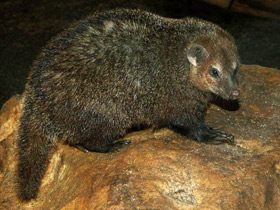The common kusimanse, the long-nosed kusimanse or simply kusimanse (Crossarchus obscurus)
The common kusimanse (Crossarchus obscurus), also known as the long-nosed kusimanse or simply kusimanse, is a small, diurnal member of the Mungotinae.
Habitat
Crossarchus obscurus is common in West Africa. Its range extends from south-western Guinea, Sierra Leone, Liberia and Côte d'Ivoire to Ghana. It inhabits the dense undergrowth of rainforest and floodplain forests; in Côte d'Ivoire it is also found in savannahs. Crossarchus obscurus can be found in mountains up to 1500 m high.
Appearance
The body length of Crossarchus obscurus varies from 30 to 37 centimetres, tail length from 15 to 21 centimetres and weight from 0.45 to 1 kg. The body is slender and elongated, and the legs are relatively short. It has five toes with retractable claws on the front and hind legs. The claws on the front legs are longer than those on the hind legs. The soles of the hind legs are hairless, except for the hind third. The shaggy coat of Crossarchus obscurus varies from dark brown to black, and the species is characterised by considerable individual variability in colouring. The undercoat of this member of the Mangusta family is light, while the hairs are brown with a light tip, giving a greyish appearance. On the head and face the hair is short and lighter than on the rest of the body, the legs are black-brown. The hairs are 10-15 mm long on the back of the head and become longer, reaching a length of up to 35 mm on the back. Both sexes have paired anal glands and there are also secretory glands on the cheeks, but males and females do not differ in colouring. Females have 3 pairs of nipples. The snout of Crossarchus obscurus is elongated, with the tip of the nose clearly placed in front of the mouth. The ears are small and round, and the pupils of the eyes are horizontally oval. Well developed auditory organs.
Life history
Crossarchus obscurus lives mainly during the day, although there are also observations of nocturnal activity. The animals live in groups of 20 or more individuals, exploring around their territory. Both sexes mark their territory with secretions from their anal and cheek glands. The group consists of one to three families, each of which consists of a monogamous pair and the cubs from the last 2-3 litters. The members of the group communicate with each other by chirping and purring. Occasionally there are clashes between conspecifics, in which the animals' fur bristles and their backs arch and limbs extend. Crossarchus obscurus has no permanent burrows; it sleeps in cracks in the ground, in empty tree trunks or in dense vegetation, in tree branches; sometimes it digs its own burrows, e.g. in termites.
Nutrition
Crossarchus obscurus feed singly or in groups. They move along the ground, overturning rocks or pieces of trees, turning over foliage lying on the ground with their long snouts and digging up prey with their forelegs. They feed on various invertebrates (molluscs, worms, spiders, crabs, woodlice, millipedes, as well as insects: copepods, cockroaches and beetles). Occasionally, Crossarchus obscurus captures frogs, snakes, lizards, birds and rodents. Small vertebrate animals are killed with a bite to the back of the head. Fruits and berries supplement the diet of Crossarchus obscurus. There are isolated reports of animals breaking eggshells by throwing them between their hind legs against a rock or cliff with their front legs.
Reproduction
The reproductive biology of the species has been investigated in captive animals. Several cycles per year have been observed in females. Seasonality of reproduction is unknown. The gestation period lasts an average of 58 days. There are 2-4 (more often 4) pups in a litter, and females may give birth up to three times a year. Newborn puppies have a body length of about 12-13 mm. They already have an undercoat. They are initially blind, their eyes opening at about 12 days of age. At three weeks of age, the female stops feeding them with milk and they reach sexual maturity at 9 months. Life expectancy in captivity is 9-10 years. Crossarchus obscurus is easy to domesticate and is sometimes kept as a pet. The species occurs quite frequently in the wild, but in some regions it is heavily hunted or poisoned by domestic dogs.
In captivity
Due to its ease of training, and social nature, the common kusimanse is commonly available in the exotic pet trade and is found in many zoos worldwide. It tends to become quite bonded to its owner, and does not interact well with any other kind of household pet. It is highly energetic, requiring a large amount of space to satiate its natural wandering instinct. Without it, it tends to pace and act out with aggression. Its dietary needs can be met with a mix of various things including commercially available crickets, mealworms, or mice, along with a quality cat food.
In captivity the risk of obesity is high, and care should be taken to assure its diet is varied, and that it gets an appropriate amount of exercise. It will often try to eat almost anything it is offered or that it comes across which seems even remotely edible, and will often become aggressive if what it perceives as a food item is taken away. Captive breeding is not commonplace, but has been done.
Conservation status
The common kusimanse is not listed as threatened or endangered, and while no exact numbers of the wild population is known, is not considered to be at risk.
















































